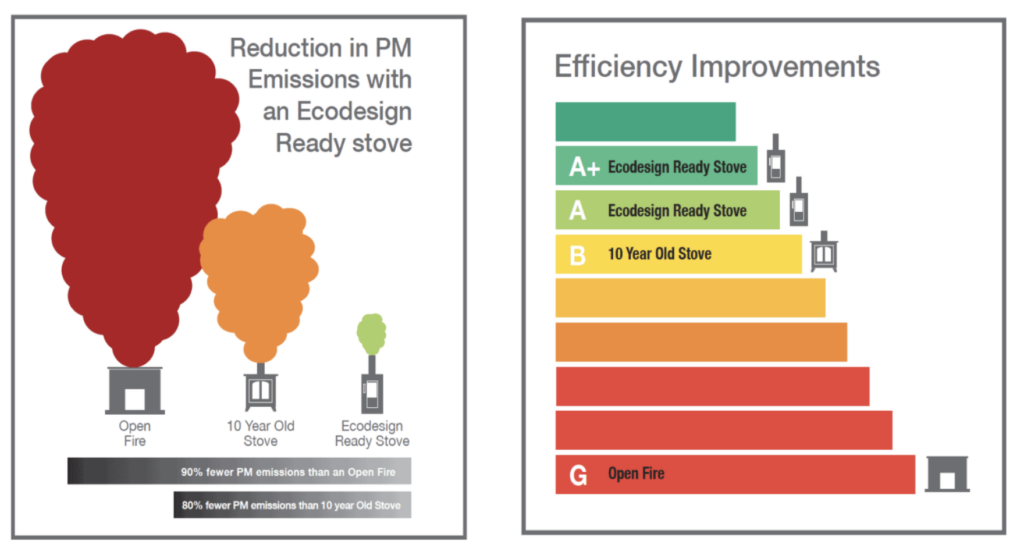While Ecodesign Ready Stoves are incredibly efficient and environmentally friendly, if you burn the wrong fuel or burn unseasoned wood or wood that is not suitable for burning (i.e. it has been painted or treated), then you will not allow your stove to run efficiently. You will also risk causing significant congestion in the flue, which in turn increases the chances of carbon monoxide poisoning and chimney fires.
A lot of misinformation and bad press around stoves recently is down to the fact that:
1. A lot of people still don’t realise the huge differences between inefficient open fires and old, outdated stoves vs Ecodesign stoves.
2. Some people are still burning rubbish (metaphorically and sometimes literally). This is causing lots of pollution, smoke and fueling the inaccurate rumours that actually burning wood is bad for the environment, which of course it certainly is not – as long as you’re using the right fuel and the right stove.
Recent enforcement is clamping down hard on people who ignore the rules around what they can and can’t burn on their stove. According to HEATS – there is a number of enforcements which have taken place, which include a man in Gloucestershire who was fined £300 for burning treated wood on this stove, which was causing an acrid smell, which was reported by local residents. The man in question pleaded guilty to failing to comply with the abatement notice issued under Section 80 (1) of the Environmental Protection Act 1990. Burning treated wood will cause toxic smoke, which poses a serious threat to human and animal health.
Smoke Control Areas:
Many areas in the UK have smoke control areas, which are in place to limit air pollution. In these areas, there is a limit on how much smoke you can emit from your chimney, and you can only burn authorised fuels unless you use an exempt appliance. In England, you can be fined £300 if your council decides your chimney releases too much smoke. You can be fined £1000 if you burn unauthorised fuels without an exempt appliance.

What can you burn in smoke control areas?
There is a list of authorised fuels you can burn in smoke control areas – More info. You can burn any of these smokeless fuels, too, unless you are using an exempt appliance:
1. Anthracite
2. Semi-Anthracite
3. Gas
4. Low volatile steam gas
Using the right wood:
Using dry/seasoned wood will help ensure a better burn, fewer emissions, and a fire, which is much easier to light. Freshly cut wood will have a moisture content of 50% or more. For correctly seasoned wood, this figure is closer to 20%. Since 1st May 2021, the government has been phasing out the sale of wet/unseasoned wood in small volumes (under 2m3) in England. This is part of the successful Ready to Burn initiative.
If you burn 10kg of dry wood with a moisture content of 20%, then you have evaporated 2kg of water. With logs containing a moisture content of 50%, you would evaporate 5kg of water (and cause lots more pollution). The wasted energy of having to evaporate the additional water impacts a fire’s performance and costs you more in the long run.
Here are our top 5 essential tips for burning wood.
#1 Always burn the best fuel you can afford. Hardwood logs are the best and can be bought kiln-dried ready for use.
#2 For maximum safety, always fit a CO (Carbon Monoxide) detector in the same room as a solid fuel combustion appliance of any kind.
#3 Don’t slumber your stove (burning very slowly) as a habitual operating method. The smoke and chemicals that can be released will shorten the life of the stove itself, the chimney, and particularly the flue liners.
#4 Reduce the amount of smoke, and keep the glass of your stove cleaner during ignition by using the top-down ignition method. Put two small-diameter logs on the grate of the stove, two further logs crossed over the first pair, followed by a firelighter and a “Jenga” style criss-cross crib of kindling on top. The wood must be fully dry, but once the fire lights, it should burn down to the base logs and be ready for the next fuel load with little intervention.
#5 The best fuel for stoves is hardwood logs having no more than 20% moisture content for the best burn. Kiln-dried or seasoned work equally as well, but they must be seasoned long enough to achieve low moisture levels.








